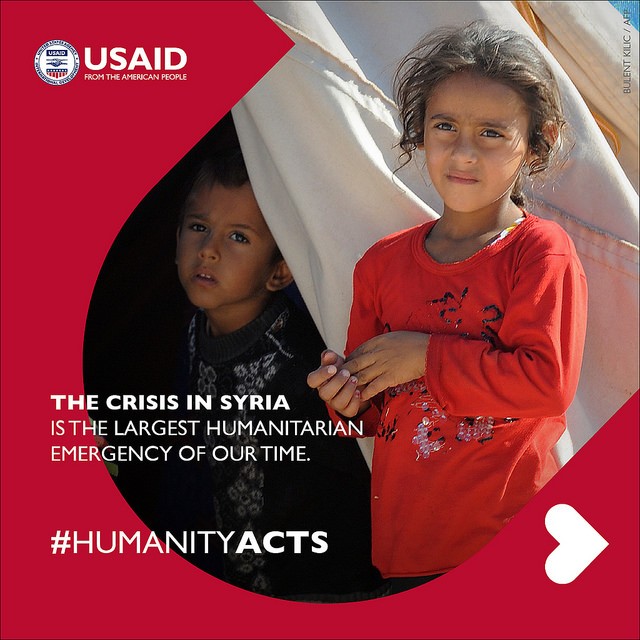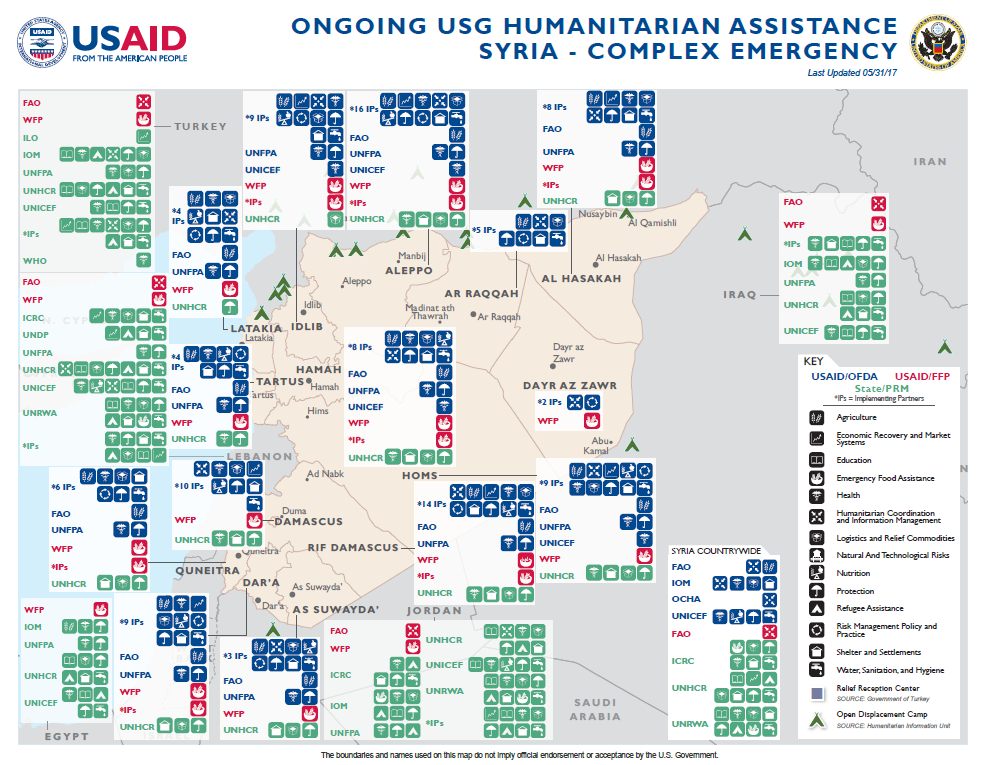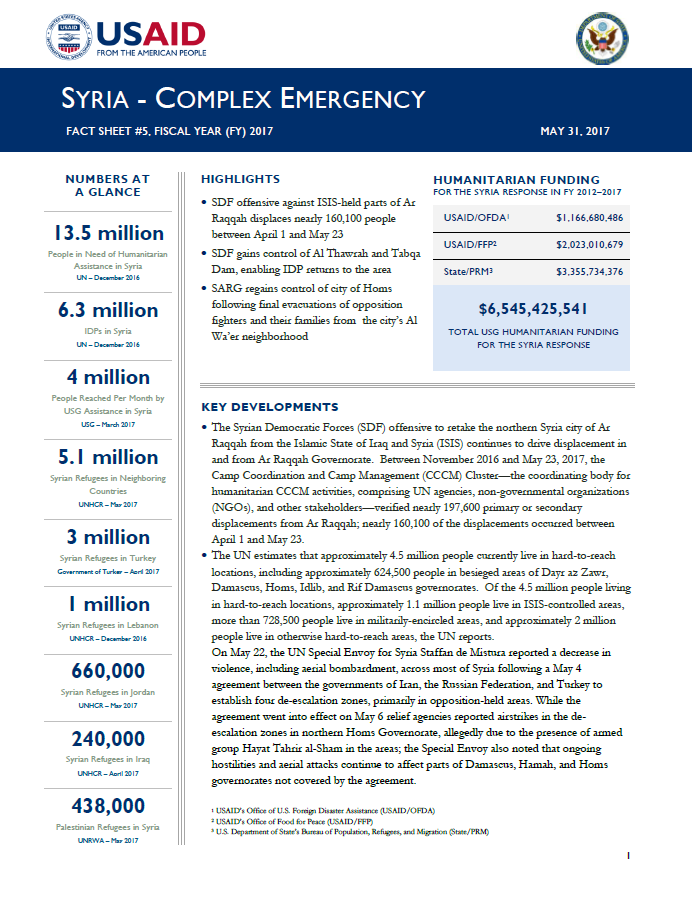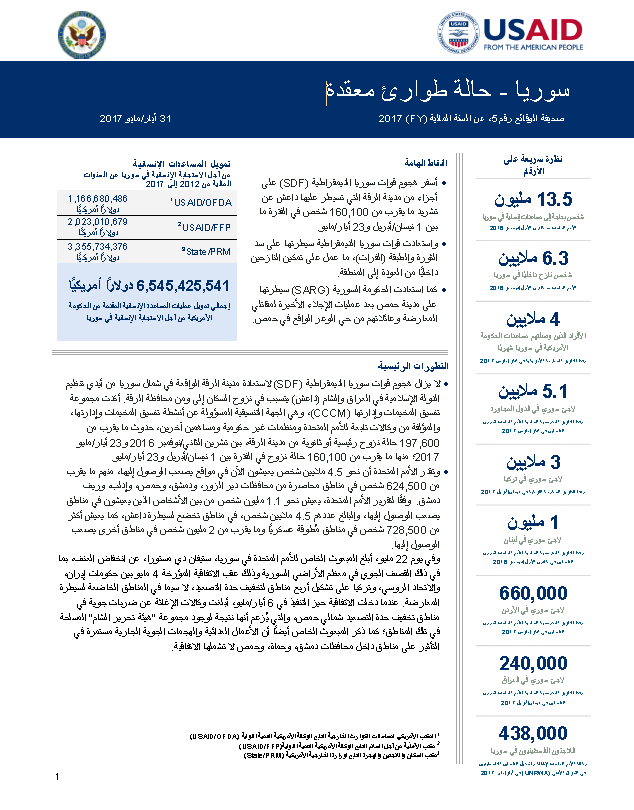- What We Do
- Agriculture and Food Security
- Democracy, Human Rights and Governance
- Economic Growth and Trade
- Education
- Ending Extreme Poverty
- Environment and Global Climate Change
- Gender Equality and Women's Empowerment
- Global Health
- Water and Sanitation
- Working in Crises and Conflict
- Disaster Assistance
- Political Transition Initiatives
- Conflict Mitigation and Prevention
- Countering Violent Extremism
- Disaster Risk Reduction
- Peacebuilding and Reconciliation
- Providing Safe & Secure Environments for Development
- Recovering From Crisis
- Resilience
- Tech Challenge for Atrocity Prevention
- World Humanitarian Day
- U.S. Global Development Lab
May 31, 2017
Highlights
SDF offensive against ISIS-held parts of Ar Raqqah displaces nearly 160,100 people between April 1 and May 23
SDF gains control of Al Thawrah and Tabqa Dam, enabling IDP returns to the area
SARG regains control of city of Homs following final evacuations of opposition fighters and their families from the city’s Al Wa’er neighborhood
Key Developments
The Syrian Democratic Forces (SDF) offensive to retake the northern Syria city of Ar Raqqah from the Islamic State of Iraq and Syria (ISIS) continues to drive displacement in and from Ar Raqqah Governorate. Between November 2016 and May 23, 2017, the Camp Coordination and Camp Management (CCCM) Cluster—the coordinating body for humanitarian CCCM activities, comprising UN agencies, non-governmental organizations (NGOs), and other stakeholders—verified nearly 197,600 primary or secondary displacements from Ar Raqqah; nearly 160,100 of the displacements occurred between April 1 and May 23.
The UN estimates that approximately 4.5 million people currently live in hard-to-reach locations, including approximately 624,500 people in besieged areas of Dayr az Zawr, Damascus, Homs, Idlib, and Rif Damascus governorates. Of the 4.5 million people living in hard-to-reach locations, approximately 1.1 million people live in ISIS-controlled areas, more than 728,500 people live in militarily-encircled areas, and approximately 2 million people live in otherwise hard-to-reach areas, the UN reports. On May 22, the UN Special Envoy for Syria Staffan de Mistura reported a decrease in violence, including aerial bombardment, across most of Syria following a May 4 agreement between the governments of Iran, the Russian Federation, and Turkey to establish four de-escalation zones, primarily in opposition-held areas. While the agreement went into effect on May 6 relief agencies reported airstrikes in the de-escalation zones in northern Homs Governorate, allegedly due to the presence of armed group Hayat Tahrir al-Sham in the areas; the Special Envoy also noted that ongoing hostilities and aerial attacks continue to affect parts of Damascus, Hamah, and Homs governorates not covered by the agreement.
Syria Complex Emergency - Map #5 Fy2017 ![]() (pdf - 497k)
(pdf - 497k)
Numbers At A Glance
13.5 million
6.3 million
4 million
5.1 million
3 million
1 million
660,000
240,000
438,000
Humanitarian Funding
To Syria Humanitarian Response
FY 2012 - FY 2017
| USAID/OFDA | $1,166,680,486 |
| USAID/FFP | $2,023,010,679 |
| State/PRM | $3,355,734,376 |
| TOTAL | $6,545,425,541 |
Syria Complex Emergency - Fact Sheet #5 Fy2017 ![]() (pdf - 472k)
(pdf - 472k)
سوريا - حالة طوارئ معقدة 1 أيار/مايو 2017 ![]() (pdf - 521k)
(pdf - 521k)
INSECURITY AND POPULATION DISPLACEMENT
The CCCM Cluster recorded the displacement of nearly 849,000 people from conflict-affected areas throughout Syria between May 2016 and May 2017, including an estimated 117,500 new displacements in May 2017 alone. The figure includes nearly 827,000 displacements from affected areas in northern Syria, including Aleppo, Ar Raqqah, Al Hasakah, Dayr az Zawr, Hamah, Homs, Idlib, and Lattakia governorates and nearly 22,000 displacements from southern Syria’s Damascus, Dar’a, Rif Damascus, and As Suwayda’ governorates.
Northern Syria
The U.S.-backed SDF offensive in Ar Raqqah continues to prompt population displacement within and from the governorate. As of May 23, the CCCM Cluster had verified nearly 197,600 primary and secondary displacements from Ar Raqqah since November; nearly 160,100 of the displacements occurred between April 1 and May 23. Many of those displaced from the city of Ar Raqqah were residing at nearby farms or in neighboring villages as of May 24, although some internally displaced persons (IDPs) had returned to their houses, according to the UN Office for the Coordination of Humanitarian Affairs (OCHA) reports.
In addition, intense fighting in and around Ar Raqqah’s Al Thawrah town had displaced approximately 55,000 people—nearly 79 percent of the town’s inhabitants—as of early May, according to OCHA. More than 15,000 people have returned to the city following a mid-May announcement that the SDF had regained control of Al Thawrah and the nearby Tabqa Dam, located approximately 40 kilometers upstream from Ar Raqqah city. The dam, which had been under ISIS control since 2013, provides critical agricultural, electrical, and water support for the region. Although the situation remains fluid, the UN anticipates additional IDP returns to the city in the coming weeks.
As of May 15, OCHA reported that Al Thawrah residents lacked access to essential goods and services, including food commodities, health services, and water, sanitation, and hygiene (WASH) infrastructure, most of which was destroyed during the clashes. Relief agencies have conducted humanitarian assessments and are mobilizing support for affected populations. As of May 23, humanitarian organizations had provided an estimated 6,000 households with ready-to-eat (RTE) rations and other food assistance, sufficient to address the emergency food needs of a six-person household for up to 10 days, OCHA reports. Additionally, OCHA notes that water supply is restored across most of the town, and local markets and at least eight bakeries are operational.
On May 2, ISIS elements reportedly infiltrated eastern Al Hasakah’s Rajm Sleib IDP screening site, where the Autonomous Administration (AA)—a Democratic Union Party-affiliated governance body presiding over parts of northern Syria—processes Iraqi refugees and Syrian IDPs for relocation to Al Hasakah’s Al Hol camp. According to OCHA, the detonation of a vehicle-borne improvised explosive device and ensuing clashes between ISIS and the Syrian Kurdish People’s Protection Unit forces resulted in approximately 50 deaths at the site the same day. First responders transferred the injured people to several hospitals in Al Hasakah, and the UN provided medical care and logistics support.
Southern and Central Syria
The Syrian Arab Republic Government (SARG) regained control of the city of Homs for the first time since 2011 following the final round of evacuations of opposition fighters and their families from the city’s Al Wa’er neighborhood, international media report. On May 20, approximately 2,500 people relocated from Al Wa’er to Aleppo’s Jarablus sub-district, Homs’ Ar Rastan District, and opposition-held areas of Idlib as part of the ninth round of evacuations from the city, U.S. Government (USG) partner the International Organization for Migration (IOM) reports. In total, more than 20,000 people have evacuated from Al Wa’er pursuant to a March 8 local truce agreement between the SARG and local authorities. With the city under SARG control, the agreement calls for the deployment of Government of the Russian Federation (GoRF) forces to provide security for residents remaining in Al Wa’er and for IDPs previously displaced from the neighborhood to return.
Relief agencies responded to the needs of evacuees from Al Wa’er, including through the provision of food assistance, relief supplies, and WASH support. IDPs arriving at the Government of Turkey (GoT) Disaster and Emergency Management Authority- and the Turkish Red Crescent-supported Zoghra IDP site in Jarablus received blankets, mattresses, and solar lamps. Additionally, a Turkey-based NGO supports a mobile kitchen at the site, which distributes meals on a daily basis, and an ambulance and mobile health clinic provide essential health services for IDPs located at the site, IOM reports.
The humanitarian situation in Rif Damascus’ Eastern Ghouta region continued to deteriorate in late April and early May, according to a recent REACH Initiative assessment. The assessment, which surveyed households in 10 besieged communities in Eastern Ghouta as well as other besieged and hard-to-reach communities in Damascus, Dayr az Zawr, and Homs, found that ongoing hostilities and restricted access had negatively impacted the availability and prices for essential commodities, including bread, fuel, and medical supplies, since the latest assessment conducted in March.
The security situation in southern Syria continues to deteriorate, with conflict between SARG forces and armed opposition groups intensifying in the Dar’a city of Dar’a al-Balad and surrounding areas, as well as a number of areas in Quneitra Governorate. Between April 1 and 30, SARG–GoRF airstrikes in a number of opposition-held towns in Dar’a killed more than 30 civilians, including children, relief workers, health care staff, and the head of the Bisr el-Harir local council, according to the UN. Two children were also killed in a land mine explosion in the Dar’a town of Da’el. Additionally, ISIS-affiliated Jaysh Khaled Ibn Waleed fighters summarily executed eight civilians in the Dar’a town of Tassil on April 28 and 29, allegedly due to perceived affiliation with other armed opposition groups, the UN reports. In early May fighting in the city of Dar’a and surrounding areas prompted approximately 3,000 people to flee the city to nearby areas in eastern rural Dar’a in early May, according to the UN World Food Program (WFP).
While the UN reports consistent access to eastern parts of the governorate, persistent tensions and intermittent clashes continue to result in periodic road closures in western Dar’a, which inhibit humanitarian operations. As of early May, the UN and humanitarian organizations were exploring alternative routes to access conflict-affected populations in western Dar’a.
SARG forces targeted the Dar’a town of Nasib, near the Jordan–Syria border, with heavy shelling on May 2 and 3, according to international media. In addition, SARG forces engaged in intensive shelling and aerial bombardment of a small village near the city of Dar’a on April 30, causing at least 12 deaths, primarily children, and triggering the temporary displacement of an unidentified number of people towards the Jordan–Syria border, according to OCHA. USG partner the UN Relief and Works Agency for Palestine Refugees in the Near East (UNRWA) reports assisting more than 1,880 Palestinian refugees who fled from Dar’a to Damascus following the recent escalation in fighting. Relief agencies expect displaced populations to return to the village as the security situation allows.
On May 2, an improvised explosive device (IED) struck a Syrian Civil Defense (SCD) ambulance in Dar’a, killing at least four White Helmets. Observers blamed Hezbollah and reported that the explosion targeted the first responders who arrived after an initial explosion, according to USG sources. During the week of May 1, airstrikes on four separate SCD centers in Damascus, Hamah, and Idlib, as well as the IED incident, had resulted in the deaths of twelve White Helmets. Overall, more than 180 White Helmets have died in the line of duty since the onset of the conflict.
HUMANITARIAN ACCESS
The UN issued revised estimates of the number of people residing in designated besieged and hard-to-reach areas in late April. The new estimates indicate that approximately 4.5 million people live in hard-to-reach locations, including approximately 624,500 people who reside in besieged areas of Dayr az Zawr, Damascus, Homs, Idlib, and Rif Damascus. Since January, the number of people in besieged areas declined by 3 percent—from approximately 644,000 to 624,500 people—and the number of people living in hard-to-reach areas declined by 4 percent—from 4.7 million people to 4.5 million people. The decreases reflect recent local truce agreements and subsequent evacuations, including from Idlib’s Al Fu’ah and Kafrayya towns and Rif Damascus’s Az Zabadani and Madaya towns, as well as from Al Wa’er. In the April revision, the UN removed the besieged designations of Az Zabadani and Khan Esheih, which no longer met the criteria for a besieged location. Of the 4.5 million people living in hard-to-reach areas, approximately 1.1 million people live in ISIS-controlled areas, more than 728,500 people live in militarily-encircled areas, and approximately 2 million people live in otherwise hard-to-reach areas, the UN reports.
In a late-April address, UN Under-Secretary General and Emergency Relief Coordinator Stephen O’Brien cautioned the humanitarian community from viewing the reduced UN figures as a positive development, emphasizing that the recent evacuations from areas such as Al Fu’ah, Kafrayya, Madaya, Az Zabadani, and Al Wa’er were not in line with humanitarian principles and that many of those who have relocated to northern Aleppo and Idlib continue to face insecurity and limited access to basic goods and services.
As of May 23, the UN and its partners had deployed 18 interagency convoys across conflict lines and conducted nearly 80 airdrops to UN-identified hard-to-reach areas in 2017, delivering multi-sector assistance to an estimated 682,000 conflict-affected people in Syria, including nearly 195,000 people in UN-identified besieged areas. In addition, the WFP-led Logistics Cluster completed nearly 230 airlifts to Al Hasakah’s city of Qamishli, delivering more than 8,200 metric tons of food assistance, health supplies, nutritional supplements, relief commodities, and WASH items for conflict-affected populations in northern Syria to date in 2017.
AGRICULTURE AND FOOD SECURITY
Humanitarian organizations, including USG partners, are responding to the urgent humanitarian needs of conflict-affected people in Ar Raqqah, and neighboring governorates, as security conditions allow. Between May 1 and 15, the UN and NGOs reached an estimated 42,000 people in Ar Raqqah and Aleppo with emergency food assistance, including RTE rations, sufficient to meet household food needs for five days, as well as other food assistance, OCHA reports. More than half of the beneficiaries were located in northern Ar Raqqah’s Ein Issa sub-district. From May 16–23, food security organizations reached approximately 17,500 people in Ar Raqqah, including 11,500 people in Ein Issa and 6,000 people in the city of Al Thawrah, with RTE rations sufficient to meet the needs of a six-person household for up to 10 days.
Countrywide, WFP aims to reach 5 million people with urgently needed food assistance, including monthly rations of bulgur wheat, pasta, pulses, and rice, among other food items, pursuant to its two-year Protracted Relief and Recovery Operation, which commenced in early January; the UN estimates that 9 million people in Syria require food assistance. The UN agency also aims to reach as many as 400,000 people in Syria with livelihood support. In April, WFP distributed food assistance for 3.8 million people across all 14 Syrian governorates, including approximately 152,000 people displaced by the ongoing fighting in Ar Raqqah.
The Cash-Based Responses Technical Working Group (CBR–TWG) and REACH Initiative jointly conducted a monthly market monitoring exercise between April 17 and 24. The exercise found a significant shortage of essential supplies in Dayr az Zawr, where the majority of items in a Survival Minimum Expenditure Basket—comprising cooking fuel, food, hygiene supplies, and safe drinking water—were unavailable, as has been the case for several months. In addition, unstable food prices were reported in UN-identified besieged areas of Rif Damascus, with median food prices changing by an average 57 percent compared to March. In the Eastern Ghouta region, the CBR–TWG and REACH reported shortages of staple food items, such as vegetables and chicken, and increasing food prices, reflecting deteriorating conditions in the area.
The national average cost of a standard food basket, which contains basic food commodities sufficient to feed a household of five for one month, was approximately $160 in April, representing a one percent increase compared to March and three percent increase compared to April 2016, according to a WFP market monitoring report. The highest cost—nearly $377—was reported in Dayr az Zawr, while the lowest cost—approximately $125—was reported in Al Hasakah.
HEALTH AND WASH
Inadequate access to WASH services and movement restrictions are among the primary humanitarian concerns for populations residing at Al Hol Camp, according to an April assessment by REACH. Approximately 50 percent of surveyed households reported water quality concerns with the communal water taps at the site, where an estimated 17,000 people, including more than 700 IDPs and 16,200 Iraqi refugees, were residing as of mid-May, USG partner the Office of the UN High Commissioner for Refugees (UNHCR) reports. In addition, approximately 12 percent of surveyed households did not have access to latrines, while 75 percent of those surveyed lacked access to showers, according to the assessment. As of April 23, relief organizations were installing additional latrines and showers to increase access to WASH services at the site.
Surveyed households also highlighted restricted movement in Al Hol, with only two percent of households reporting the ability to leave the camp temporarily to meet day-to-day needs, while 29 percent of respondents reported the ability to leave in cases of medical emergencies. According to the assessment, all surveyed households reported having access to a health care facility, and medical supplies were available at the site. Additionally, nearly all respondents reported receiving food assistance in the previous 30 days.
From May 4 to 11, health organizations recorded more than 20 suspected cases of acute flaccid paralysis, a diagnosis commonly caused by the polio virus, in Dayr az Zawr. USAID/OFDA partner the UN World Health Organization (WHO) tested samples collected from suspected patients, seven of which were negative for polio; the results of the remaining samples were pending as of May 11. Health actors have supported more than 20 polio vaccination campaigns since 2013—when polio reemerged in Syria following a 14-year gap in reported cases—and no new cases had been reported since January 2014, according to WHO. From April 19–27, health organizations conducted a polio vaccination campaign that reached nearly 8,200 children younger than five years of age in the ISIS-besiged city of Dayr az Zawr.
Amid the evacuations from Al Wa’er, Turkey-based Health Cluster members provided more than 50 ambulances and operationalized seven hospitals in northern rural Aleppo and Idlib to receive patients. Cluster members also mobilized four mobile clinics and two triage points along the evacuation route. Health organizations also provided more than 1,000 evacuee children with polio, measles, and rubella vaccinations.
SHELTER AND PROTECTION
As of May 22, relief agencies continued to prepare Ein Issa’s IDP camp—previously referred to as the cotton warehouse—to accommodate additional IDP arrivals from Ar Raqqah, with approximately 370 tents erected at the site as of May 22; UNHCR plans to erect an additional 330 tents at the site in the coming weeks. In addition, the UN agency is distributing emergency relief supplies at the site, at which approximately 25,000 IDPs from the Aleppo countryside and Ar Raqqah sub-district were residing as of May 15, according to OCHA. The cumulative number of IDPs in the sub-district remains unverified and fluid as IDPs arrive from and depart for other areas.
As of May 26, UNHCR had distributed approximately 5,500 blankets, 3,500 mattresses, 1,200 kitchen sets, 1,100 plastic sheets, and 1,500 water storage containers, among other relief items, to IDPs at the Ein Issa camp. UNHCR is also engaging with the AA to ensure IDPs are able to access critical medical services outside the camp.
At Al Hasakah’s Mabroka IDP camp, UNHCR is completing repairs to the camp’s road network and constructing communal kitchens.
In response to the recent displacement from and within Ar Raqqah, UNHCR is providing IDP households at Ein Issa and Mabroka IDP camps with protection services, including conducting outreach to IDPs, ensuring access to child protection services, and providing advice related to documentation. The UN agency aims to expand its protection services for Ar Raqqah IDPs in the coming weeks.
REFUGEE ASSISTANCE
UNHCR had registered nearly 5.1 million Syrian refugees in neighboring countries, including Iraq, Jordan, Lebanon, Turkey, as well as Egypt and other parts of northern Africa, as of May 18. Turkey remains the largest host nation, with nearly 3 million Syrian refugees registered in the country.
WFP, in coordination with the GoT, the Turkish Red Crescent, and the European Commission’s Directorate-General for Humanitarian Aid and Civil Protection (ECHO), continues to implement the Emergency Social Safety Net program, a cash-based assistance program which aims to assist vulnerable refugees to meet basic needs for food, clothing, medicine, rent, and utilities. As part of the program, households receive debit cards pre-loaded with $36 per person for one month; the program aims to reach 1 million refugees sheltering in Turkey in 2017.
CONTEXT
Following the commencement of peaceful demonstrations against the SARG in March 2011, President Bashar al-Asad pledged legislative reforms. However, reforms failed to materialize, and SARG forces loyal to President al-Asad began responding to demonstrations with violence, leading armed opposition groups to retaliate.
At a November 2012 meeting in Doha, Qatar, Syrian opposition factions formed an umbrella organization—the National Coalition for Syrian Revolutionary and Opposition Forces, also known as the Syrian Coalition. The USG recognized the coalition as the legitimate representative of the Syrian people on December 11, 2012. On March 19, 2013, the Syrian Coalition established the Syrian Interim Government, which opposes the SARG and is based in decentralized locations throughout opposition-held areas of Syria.
On July 14, 2014, the UN Security Council adopted UN Security Council Resolution (UNSCR) 2165, authorizing UN cross-border and cross-line delivery of humanitarian aid to conflict-affected populations without SARG approval. The resolution permits the UN’s use of four border crossings from Turkey, Jordan, and Iraq—in addition to other crossings already in use by UN agencies—for delivery of humanitarian assistance into Syria. The resolution also establishes a monitoring mechanism under the authority of the UN Secretary-General and with the consent of the neighboring countries to ensure that deliveries across these border points contain only humanitarian items. The UNSC has subsequently adopted several resolutions renewing the mandate of UNSCR 2165, most recently in December 2016 with the adoption of UNSCR 2332, extending the authorities granted until January 2018.
Prior to the start of the conflict, UNRWA had registered approximately 560,000 Palestinian refugees in Syria, with more than 80 percent living in and around Damascus. Intense fighting in and around some Palestinian camps and neighborhoods has significantly affected Palestinian refugees in Syria. UNRWA estimates that approximately 60 percent of Palestinian refugees are displaced within Syria, with a further 110,000 Palestinian refugees displaced to neighboring countries. Syria also hosts an estimated 24,000 Iraqi refugees and asylum seekers, primarily in the greater Damascus area, as well as more than 3,200 refugee persons of concern from other countries.
PUBLIC DONATION INFORMATION
The most effective way people can assist relief efforts is by making cash contributions to humanitarian organizations that are conducting relief operations. A list of humanitarian organizations that are accepting cash donations for disaster responses around the world can be found at www.usaid.gov/crisis/syria.
The USG encourages cash donations because they allow aid professionals to procure the exact items needed (often in the affected region); reduce the burden on scarce resources (such as transportation routes, staff time, and warehouse space); can be transferred very quickly and without transportation costs; support the economy of the disaster-stricken region; and ensure culturally, dietary, and environmentally appropriate assistance.











Comment
Make a general inquiry or suggest an improvement.